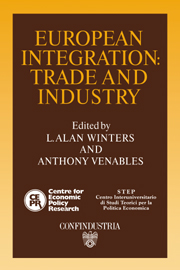Book contents
- Frontmatter
- Contents
- List of figures
- List of tables
- Preface
- Acknowledgements
- List of conference participants
- 1 European integration: trade and industry
- 2 Completing the internal market in the EC: factor demands and comparative advantage
- Discussion
- 3 External effects and Europe's integration
- Discussion
- 4 The quality and production of textiles and clothing and the completion of the internal market
- Discussion
- 5 Competition and imports in the European market
- Discussion
- 6 The structure and determinants of East–West trade: a preliminary analysis of the manufacturing sector
- Discussion
- 7 1992 and EFTA
- Discussion
- 8 Technology policy in the completed European market
- Discussion
- 9 Corporation tax, foreign direct investment and the single market
- Discussion
- 10 Japanese direct manufacturing investment in Europe
- Discussion
- Index
Discussion
Published online by Cambridge University Press: 07 September 2010
- Frontmatter
- Contents
- List of figures
- List of tables
- Preface
- Acknowledgements
- List of conference participants
- 1 European integration: trade and industry
- 2 Completing the internal market in the EC: factor demands and comparative advantage
- Discussion
- 3 External effects and Europe's integration
- Discussion
- 4 The quality and production of textiles and clothing and the completion of the internal market
- Discussion
- 5 Competition and imports in the European market
- Discussion
- 6 The structure and determinants of East–West trade: a preliminary analysis of the manufacturing sector
- Discussion
- 7 1992 and EFTA
- Discussion
- 8 Technology policy in the completed European market
- Discussion
- 9 Corporation tax, foreign direct investment and the single market
- Discussion
- 10 Japanese direct manufacturing investment in Europe
- Discussion
- Index
Summary
Victor Norman's study is clear and well argued, and I agree with his conclusions. These conclusions also serve as an agenda for future research: less emphasis on trade in manufactures and more on the many other aspects of EFTA's integration with the EC. I think this in fact is the most important message of Norman's study. So let me expand somewhat on this theme.
The European Free Trade Association (EFTA) is an association of states, each one of which has its own free trade agreement in manufactures with the EC. EFTA has no supernational institutions, and no long-run political aims. There are no EFTA–EC free trade agreements covering agricultural products, or services, or labour mobility, or capital mobility. In short, the 1992 Internal Market programme covers many more issues than does the present EFTA Charter.
A starting point of Victor Norman is the assumption that the upcoming agreements on the European Economic Space (EES) probably imply that the EFTA countries will have to accept the Community's common external trade policy. This seems to me very unlikely, especially since both sides agree that agriculture is not to be included in any EES agreement. Border controls will consequently have to be kept for this reason, if for no other. However, the preconditions for the EES negotiations changed during 1989, and it now seems plausible to assume that during the 1990s all the EFTA countries – possibly with the exception of Switzerland – will become full EC members. Then, of course, these EFTA countries will also be members of the EC's common policies, including the external commercial policy.
- Type
- Chapter
- Information
- European IntegrationTrade and Industry, pp. 139 - 141Publisher: Cambridge University PressPrint publication year: 1991



